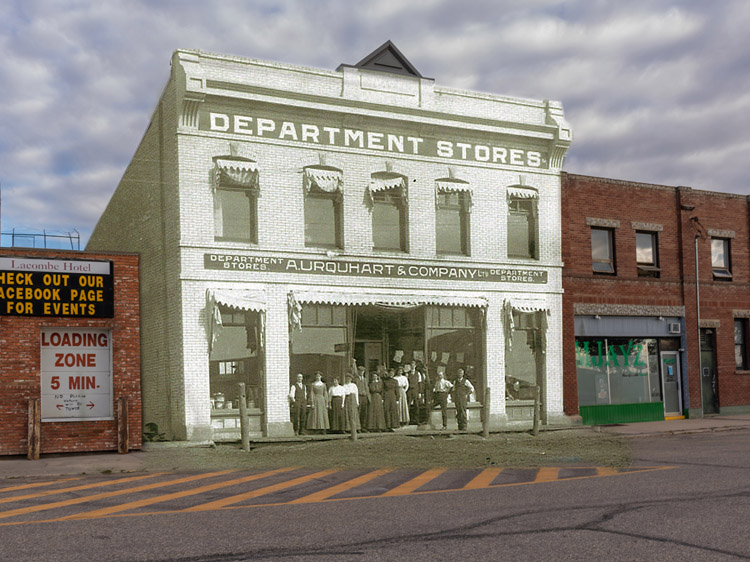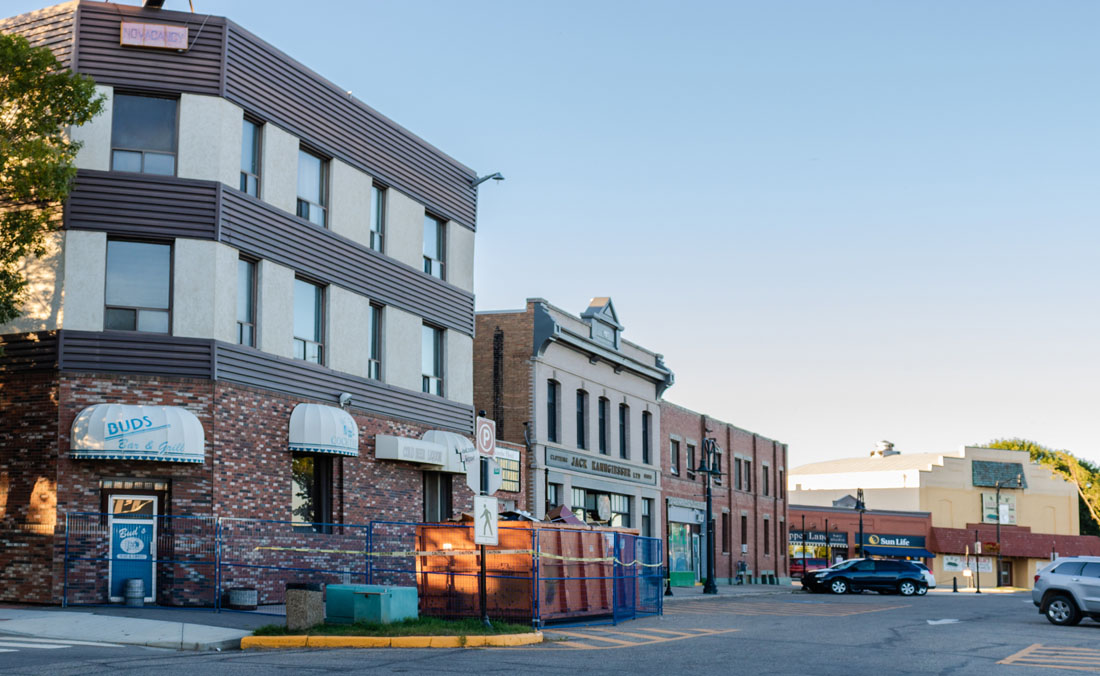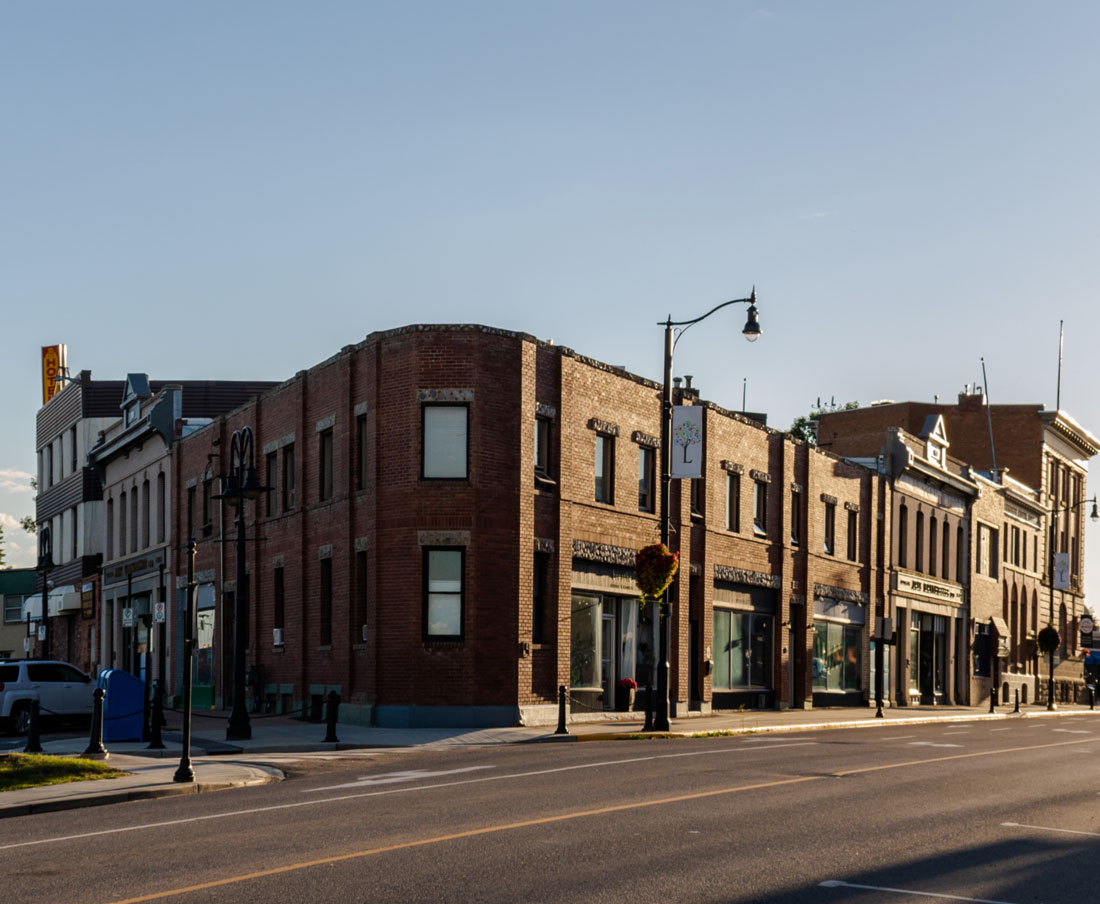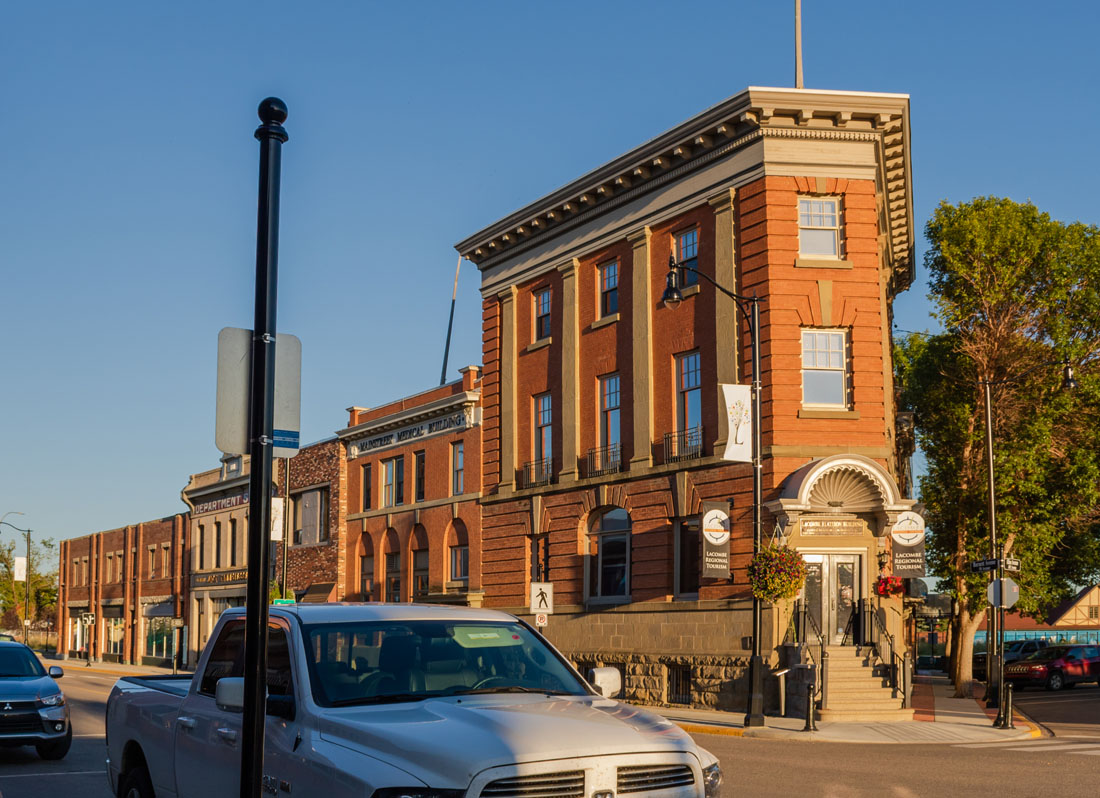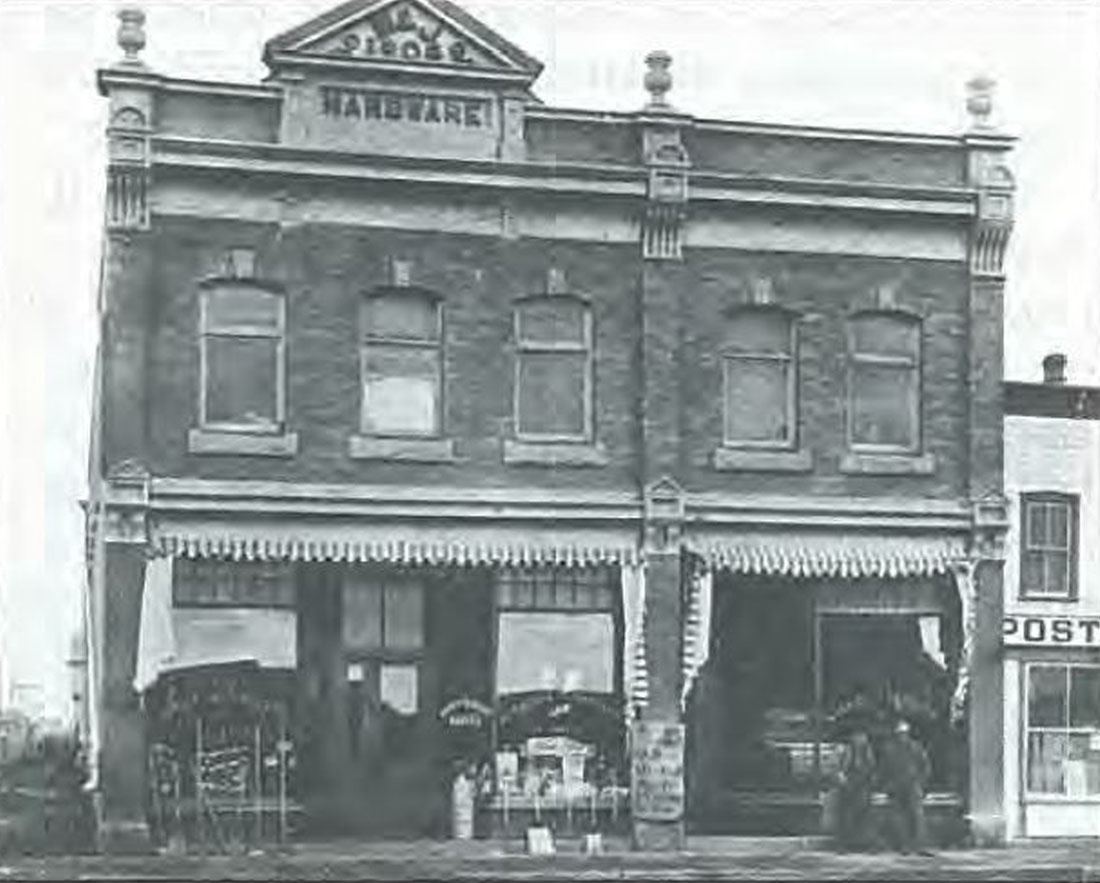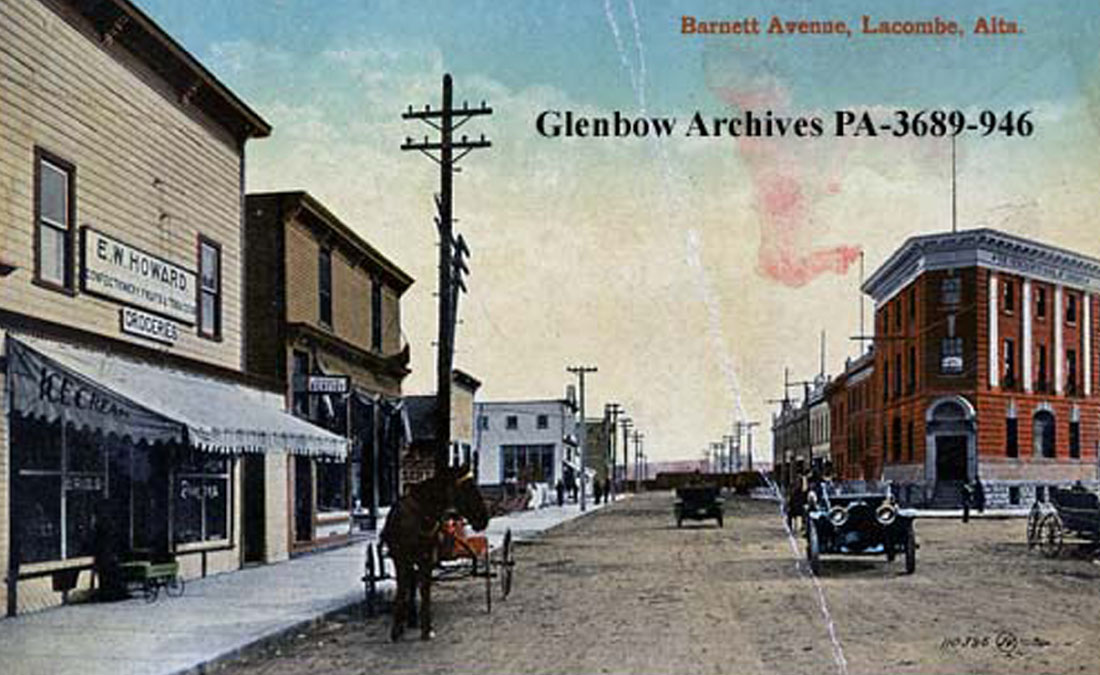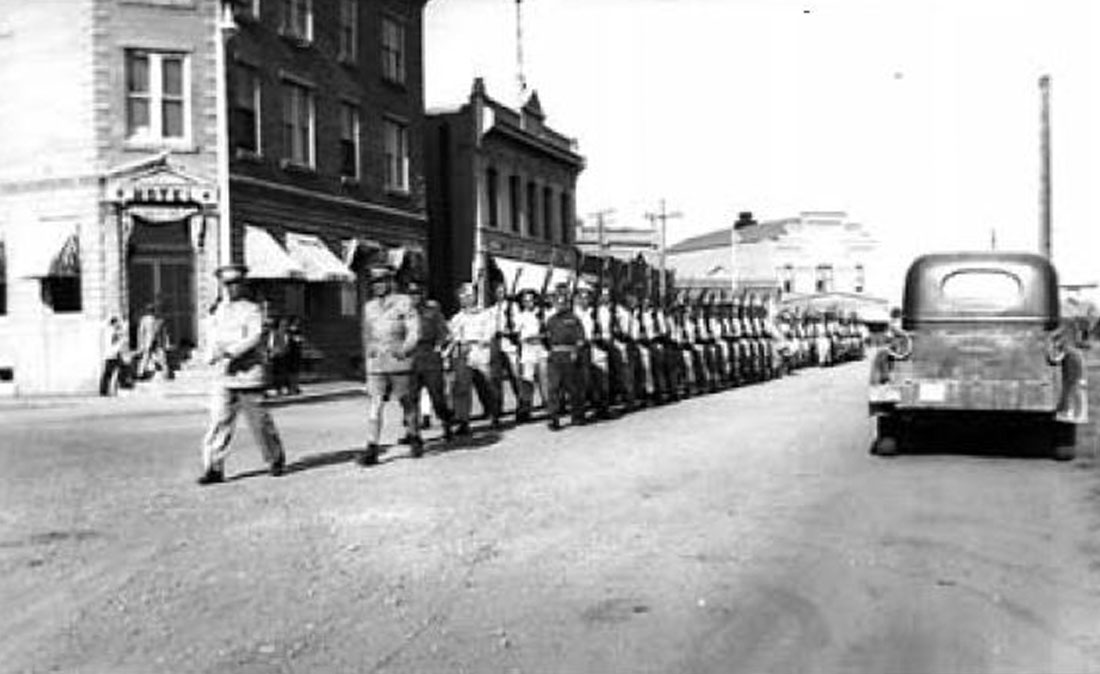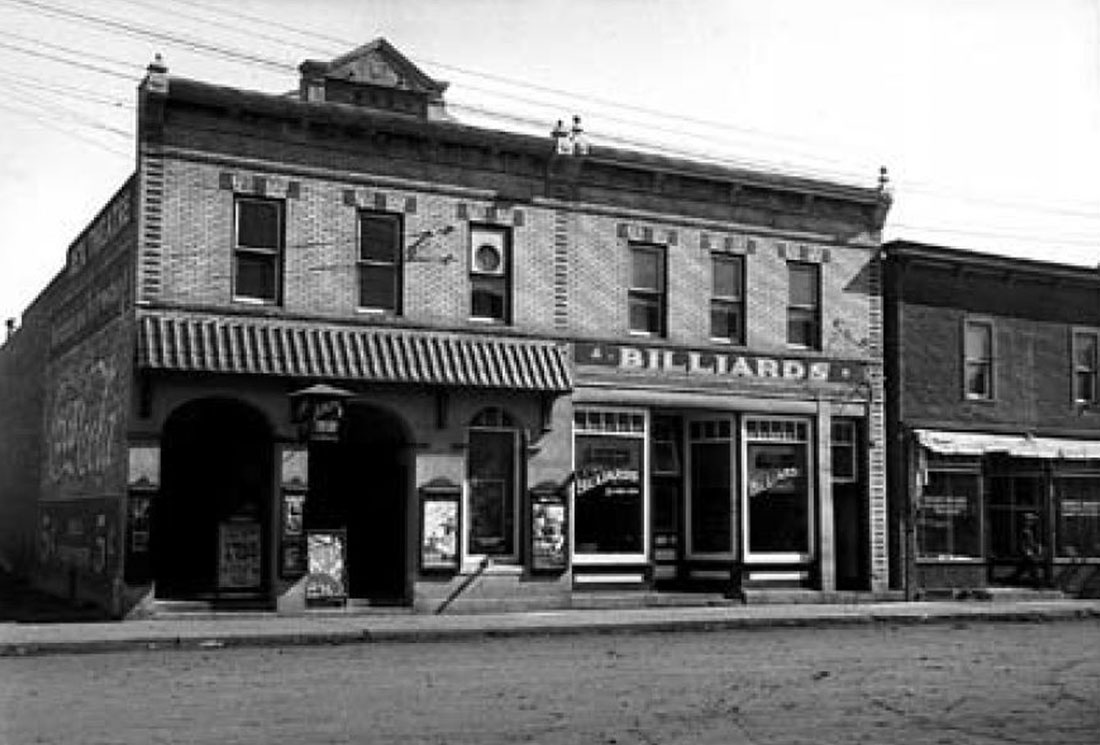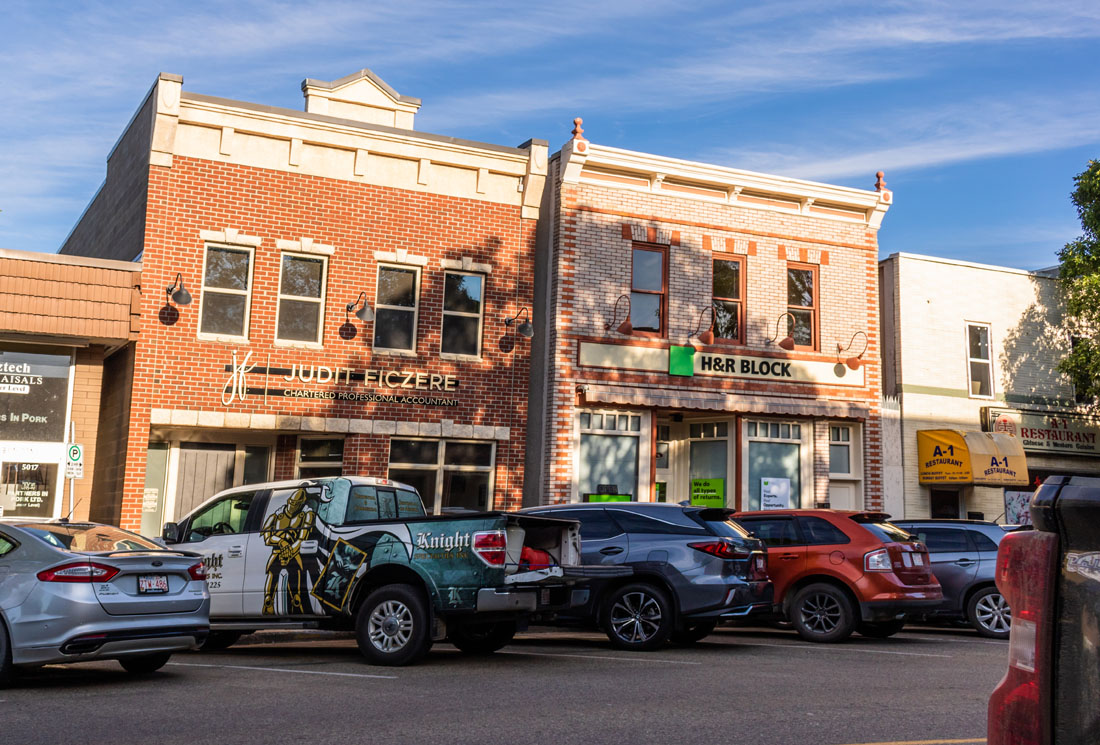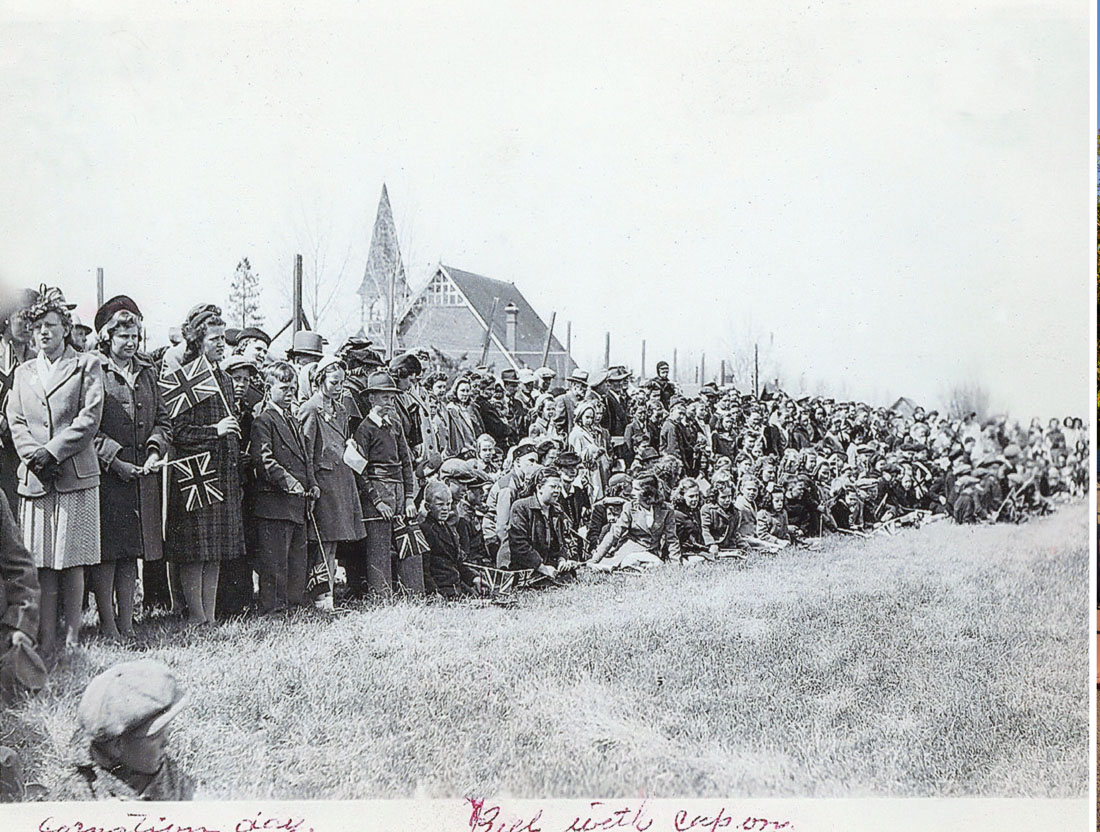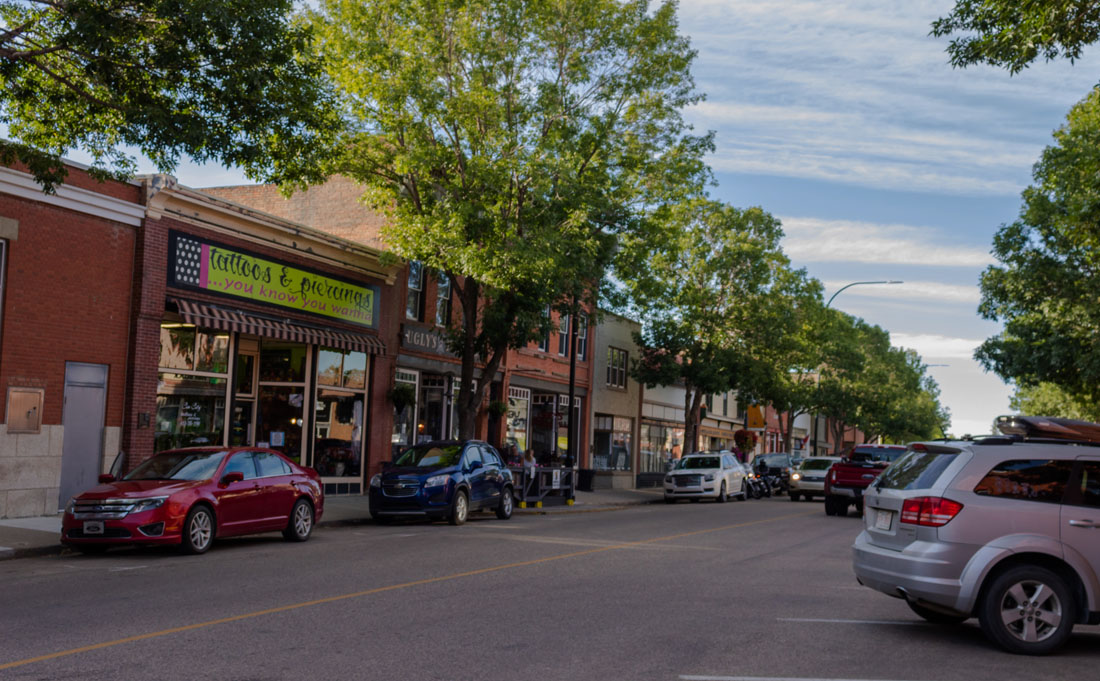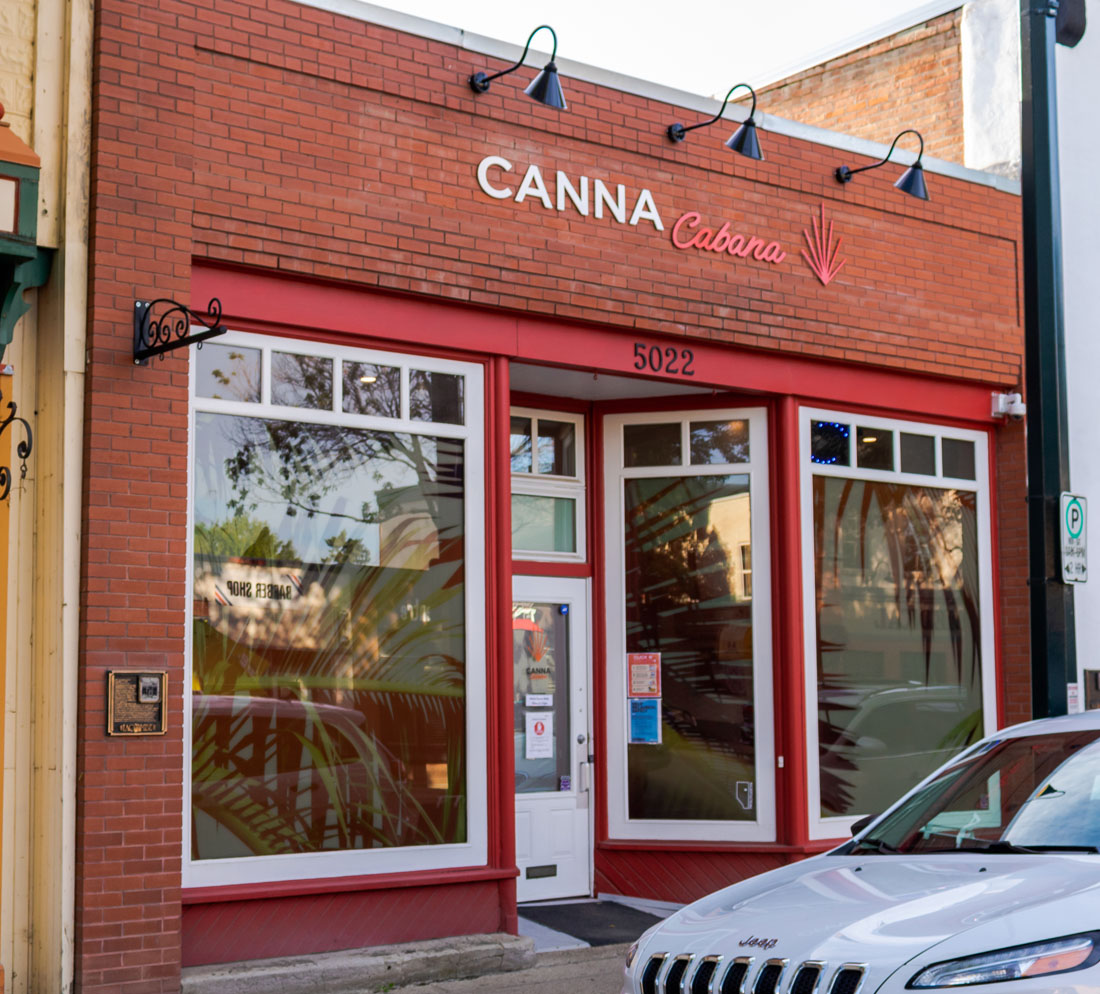Nestled in the rolling prairie of central Alberta, Lacombe sits at the midpoint of the main route connecting Edmonton and Calgary. The region has been home to First Nations peoples like the Cree, Sautleaux, Blackfoot, Dene and Sioux for at least 12,000 years. Much more recent is European settlement, which began in the 1880s, and gained speed after the Canadian Pacific Railway built a station here in 1891. Thanks to its location on important road and rail networks, Lacombe grew in size and importance in the early years of the 20th Century. Many impressive business blocks and opulent homes were erected, and a remarkable number of these structures survive to the present. As a result the picturesque downtown boasts one of the highest concentrations of heritage buildings on the prairies. Today Lacombe is a small and prosperous city, with around 13,000 inhabitants. The picturesque downtown has rapidly revitalized in recent years, and draws visitors from far and wide.
This project is a partnership with Lacombe Regional Tourism. We also wish to thank the Michener House Museum & Archives for their generous support.
We respectfully acknowledge that Lacombe is located on Treaty 6 territory, a traditional meeting grounds, gathering place, and traveling route to the Cree, Saulteaux, Blackfoot, Métis, Dene and Nakota Sioux. We respectfully acknowledge all the many First Nations, Métis, and Inuit whose footsteps have marked these lands for centuries.
Virtual Tours
Tours
Explore
Lacombe
Then and Now Photos
Bulls on the way to Auction
1902
A herd of bulls and ranchers mill around in front of the Victoria Hotel. They are on the way to auction in Calgary.
Aftermath of the Fire
1906
People walk through the pile of smouldering rubble left by a devastating fire that destroyed most of the Flatiron Block, leaving only the Merchants Bank standing (which you can see at left). This fire led to a change in Lacombe's building codes, requiring all commercial buildings in the town be made of brick.
Aftermath of the Fire (2)
1906
People walk through the pile of smouldering rubble left by a devastating fire that destroyed most of the Flatiron Block, leaving only the Merchants Bank standing (centre). This fire led to a change in Lacombe's building codes, requiring all commercial buildings in the town be made of brick.
Bustling Street Scene
Lacombe & District Historical Society 90.1.620
1907
Lacombe's streets are filled with activity here, with many men and women patronizing some of the local businesses, while horse-drawn buggies and cars share the road. The building at left is the Adelphi Hotel.
This grand hotel building was constructed between 1907 and 1908 on the prominent corner across from the local railway station; it was built after the original wood frame Albion Hotel had been destroyed in the downtown fire of 1906. A.T. Inskip was the owner of both the Adelphi and the new Lacombe Hotel buildings and, following the fire, Inskip acquired more land from the flat iron block to build his dream business – an impressive three-storey hotel, which also contained the Town post of fice at one time. Using locally cast cement blocks to create the look of sandstone, Inskip designed the hotel in the style of Italian Renaissance. The building originally had two street facades to increase street presence and to allow patrons easy access to the building, and was accessible through three entrances.
The third entrance was through the basement, which connected to a tunnel under Railway Street – this tunnel led to an excavation under the C&E Railway Station. In the era of prohibition, the hotel could supply patrons with the finest contraband delivered by rail from providers in Medicine Hat. Bringing the contraband into Lacombe required the cooperation of trusted employees of both the rail service and the hotel. According to local legend this tunnel also served a tunnel that ran beneath the establishments lining the west side of Nanton Street. Another ploy used for delivery of this prized product featured the bread imported by train from a baker in Medicine Hat. His specialty was a hollow loaf, a product specially designed to accept a bottle of the finest.
The building features a variety of exterior textures and treatments including stone blocks with coarse rustication and smooth stone sections, it also features a flat roof with a corner entrance, and both a roofline and beltline cornice.
- Text from Town of Lacombe Municipal Heritage Survey 2010 (p. 2).
View from the Tracks
Lacombe & District Historical Society 90.1.632
1908
A photo taken from the railway tracks giving an excellent view of downtown and showing several horsedrawn buggies.
The Urquhart Block
Lacombe & District Historical Society 90.1.914
ca. 1910
Staff pose for a photo in front of the Urquhart Block.
Built in 1907, the Urquhart Block is distinguished by an uncommon triangular footprint created by the intersection of the original land survey with the oblique alignment of the Calgary and Edmonton Railway line. The block's triangular plotting and grouping of heritage buildings makes it one of Alber ta's premier collections of early twentieth century commercial buildings.
The peculiar shape of the block's footprint impacts the Urquhart Block building a unique feature: dual storefronts. Though the presence of two storefronts on the building is unusual, the design of the storefronts is typical of Alber ta's early commercial buildings, featuring the division of their surfaces into three sections: the main floors with recessed entrances, large display windows surmounted by transoms, and bulkheads; second storeys separated from the first by sign bands and featuring the symmetrical arrangement of multi-paned windows; and crowning cornices surmounted by parapets and a central pediment. The yellow brick with red mortar imparts a distinctive character to the building. It is a vital contributor to the lively historic ambience of Lacombe's central business district.
- Text from Town of Lacombe Municipal Heritage Survey 2010 (p. 29).
Shops on 50th Street
ca. 1910s
This photo shows a number of shops on 50th Street, as well as men and horses standing in the street. Notice the horses harnessed to the hitching post on the right.
The Corner Business Block
Lacombe & District Historical Society 90.1.376
ca. 1910s
n 1903, a brick building had been built at this location, owned by Harr y Brethour Howell, a druggist and optometrist. In 1906 a fire destroyed the brick building and all the others on the block save for the Merchants Bank. Although the building was rebuilt in 1907 it burned again in 1911. The current building was built in 1928 by Percy S. Cull and Carl Pangle; the second floor was added in 1947.
- Text from Town of Lacombe Municipal Heritage Survey 2010 (p. 8).
The Merchants Bank
ca. 1910s
The Merchants Bank of Canada Building, also known as the Flat Iron Block, is the most recognizable and treasured building in the Town of Lacombe.
Designed in the Beaux-Ar ts tradition of architecture, the building is an excellent example of the influence of the Edwardian-era on western Canadian architecture. The Merchants Bank, an early financial institution, first opened in Lacombe in 1901, however, construction began on a permanent building for the company in 1903. Completed in 1905, one year prior to the fire that would destroy much of the downtown of Lacombe, the Merchants Bank stood as a sophisticated and unique building in a community that was beginning to grow and flourish. Following the fire of 1906, many of the buildings on this block were rebuilt to reflect the grandeur of the Merchants Bank Building, a grandeur that can still be seen today on the streetscape of downtown Lacombe. The Merchants Bank, was a successful company and the first bank in the Town of Lacombe; it merged with the Bank of Montreal in 1922. The Bank of Montreal continued to occupy the building until 1967. Through the provision of financial ser vices, both the Merchant's Bank of Canada and the Bank of Montreal played a significant role in the early development of not only the Town of Lacombe, but many other communities throughout the province.
This is a rare example of a commercial building following the style of the 1902 Fuller Building in New York. While buildings of this shape were constructed in North America in the late nineteenth century, the Fuller, more commonly referred to as the Flatiron Building, is considered by many as the prototype of buildings of this type, so named for their distinctive triangular shape that resembled a flat iron. The basic design of the building is typical of the dominant architecture preferred by financial institutions of the time, to convey a sense of power, security and reliability to customer's and competitors alike. Hogle & Davis were the architects for the Merchant’s Bank, and designed a number of branch banks throughout the country between 1904 and 1919.
Despite its different uses, the Merchants Bank building has always been an important structure in the community. For many years, the town’s water pump was located outside the building, making it an important gathering place for the local people.
- Text from Town of Lacombe Municipal Heritage Survey 2010 (p. 33).
Telephone Repairmen
ca. 1910s
Two telephone repairmen are perched atop a telephone pole on 51st Street.
Horse Drawn Buggy
Lacombe & District Historical Society
ca. 1910s
A covered horse-drawn carriage is parked on 50th Avenue and in the background you can see the Merchants Bank Building.
M & J Hardware
Lacombe & District Historical Society
ca. 1910s
Built in 1906, the M & J Hardware Building is a fine example of the architecturally eclectic commercial buildings erected throughout small communities in Alberta in the early twentieth century.
Mar ying utilitarian considerations with Edwardian Classical Revival stylistic elements, these structures typically featured readily available materials simply massed in an elegant, though not ostentatious, classical composition. Much of the exterior of the M & J Hardware Building is composed of locally-made brick and sandstone. These materials are artfully arranged in a series of decorative classical features, including pilasters and segmental-arch windows with keystones. These elements are complemented by dominant cornices, a prominent pediment, and ornamental urns crowning the pilasters. The union of strong materials, solid massing, and elegant detailing projects an air of permanence, simplicity, and balance - qualities deemed vital for commercial endeavors in early Alberta. The M & J Hardware Building has undergone extensive conservation work and is now an integral par t of Lacombe's historic downtown streetscape.
The M and J Hardware Building recalls the early commercial development of Lacombe and the significant contributions of the enterprise's founders to business and social life in the community. Like many central Alberta communities, Lacombe's origins can be traced to the completion of the Calgary & Edmonton Railway in 1891. The new line stimulated the creation of numerous stations and a host of new settlements. In 1902, the community known as Barnett was incorporated as the Town of Lacombe. One year prior, local entrepreneurs Norman Morrison and James Johnston had purchased the community's first general store. They operated their hardware business out of this site until 1905, by which time they had outgrown the store and required new accommodations. They constructed the stately M & J Hardware Building in 1906. The business was expanded in 1912 to accommodate a Ford motorcar repair shop and garage at the back of the building; gas pumps were added in 1915.
Both Morrison and Johnston were prominent local citizens; their elegant residences still exist as testimony to their social status. Morrison was especially important to the nascent community of Lacombe. Not only was he one of the wealthiest citizens in the district (and the owner of the first automobile in town), but he also served as alderman and mayor. M & J Hardware remained in operation from 1901 until 1975, making it Lacombe's longest running family business.
- Text from Town of Lacombe Municipal Heritage Survey 2010 (p. 27).
Snowy 50th Street
Lacombe & District Historical Society
ca. 1910s
A view past the Puffer Chung Block towards the Merchants Bank on a wintry day.
Puffer Chung Block
Lacombe & District Historical Society
ca. 1910s
Following the fire of 1911, the Puffer/Chung Block was constructed as a single but divided building for two Lacombe businessmen. William Puffer and Hop Chung had both operated businesses, a butcher shop and a laundry respectively, adjacent to the Victoria Hotel, both of which were lost when the Hotel was destroyed by fire on New Years Day of 1911.
Puffer and Chung decided to join together to construct a brick building that would properly house both of their businesses. Both William Puffer and Hop Chung were important, locally active men in the Lacombe community. Puffer, who became Lacombe’s first ML A in 1905 and held the position until 1917, lobbied heavily to bring the Federal Research Station to the Town and was involved in many other local businesses and community organizations. Hop Chung was one of Lacombe’s first Chinese residents and experienced the restrictions on Chinese immigration first-hand when he tried to send for his wife and daughter, who were still living in China. An imposed head tax of $500 per person made immigration of entire families almost impossible. However, illustrating the true nature of their friendship, William Puffer paid for Chung’s wife and daughter to come to Lacombe. The arrival of the two women was a significant event as there were fewer than 100 Chinese women in the province at the time.
The physical significance of the Puffer/Chung Block lies in its masonry construction, arched brick window openings, brick dentils and cornice and columns that flank the central entrance between the two separated main floor commercial spaces.
- Text from Town of Lacombe Municipal Heritage Survey 2010 (p. 7).
Adelphi Hotel View
Lacombe & District Historical Society 91.1.318
1913
A photo taken from across the street showing the Adelphi Hotel and one of the frontages of the Urquhart Block.
Postcard of 50th Ave
ca. 1914
A hand-coloured postcard showing cars on 50th Avenue sharing the road with horse-drawn buggies. The Merchants Bank is on the right.
Grace Church and the Michener House
Lacombe & District Historical Society 90.1.50a
1915
The building on the right, Grace Methodist Church, once stood on this spot. To the right is the Michener House, which is today a museum.
Michener House is the oldest building in Lacombe. Built in 1894 as a home for Lacombe’s Methodist ministers, the modest wood frame, front- gabled house exists today as one of the Town’s most significant landmarks. In 1899, Reverend Edward Michener accepted a posting as a Methodist minister for the Lacombe circuit. He took up residence in the town's modest parsonage, located just north of the Methodist Church. On April 19, 1900 Daniel Roland Michener was born in this simple frame house that now bears his name. His family resided here for six weeks after his birth before moving to Red Deer. The home has been largely restored to its turn-of-the-century appearance.
Roland Michener gained renown as an accomplished lawyer, politician, and statesman in Canada. He received his undergraduate degree at the University of Alberta before pursuing graduate studies at Oxford on a Rhodes Scholarship. Upon returning to Canada, he worked for many years as a lawyer in Toronto before launching his political career. He was first elected to political office in 1945 when he won a seat in the Legislative Assembly of Ontario. Eight years later he was voted into the Canadian Parliament representing St. Paul's, Toronto. From 1957 until 1962, Michener served as Speaker of the House of Commons and was acclaimed as one of the best Speakers since Confederation. He also held posts as the High Commissioner to India and the first Canadian Ambassador to Nepal. Michener is best known for his work as Canada's Governor- General, a position he held from 1967 until 1974. During his tenure, he directed several significant developments in the office of the Governor- General.
Michener presided over the nation's centennial celebrations, presented the first Order of Canada honours, relaxed some of the formal protocols associated with the Governor- General, and instituted periodic meetings with provincial Lieutenant Governors. He and his accomplished wife, Norah, were a progressive vice-regal couple who travelled extensively in Canada and abroad. A vigorous sportsman, "Canada's Jogging Governor- General" - as Michener was sometimes called - also championed physical activity for Canadians during his term through his advocacy on behalf of the Participaction Program. In honour of his service, he was presented the Royal Victorian Chain by Queen Elizabeth II in 1973, one of only two Canadians to have received the tribute. The Government of Alberta celebrated Michener's accomplishments by naming a mountain in his honour.
Michener passed away in 1991.Michener House was declared a Provincial Historic Site in 1971 and was restored to its original appearance prior to opening as the Michener House Museum in 1984.
- Text from Town of Lacombe Municipal Heritage Survey 2010 (p. 13).
Military Parade
Lacombe & District Historical Society 90.1.789
1922
A company of soldiers march past the Adelphi Hotel.
Day Block
Lacombe & District Historical Society 90.1.887
1930
Built in 1907, the Day Block was an important building in the community. The building was built for Alfred H. Day who arrived in the Lacombe area in 1896.
Day married local widow Caroline Marjorie Glass in 1900 who, at the time, owned a small wood-frame general store on the present site of the Day Block. The building is well remembered for housing Day’s Opera House in its second storey. The Day Block was built on the lot after the general store had been moved.
The building has since been covered with stucco; however, the outline of the ornate brickwork beneath can still be seen. The Day Block at one time featured brick corbelling, diagonal brick coursing, string courses, and brick dentils; it continues to exhibit its false front or ‘boomtown front’, a common early architectural trend to make buildings appear larger than they actually were.
- Text from Town of Lacombe Municipal Heritage Survey 2010 (p. 25).
Royal Bank of Canada
Lacombe & District Historical Society 990.1.890
ca. 1930
Built between 1913 and 1914, following the devastating fire of 1911 and the start of the First World War, the Royal Bank of Canada was established at the prominent corner of Lacombe’s two main commercial streets, 50th Street and 50th Avenue.
The Royal Bank remained in the building for many years and has since been the location of several doctor’s offices as well as the Alberta government’s office for Hail and Crop Insurance. The Royal Bank building is one of Lacombe’s most recognizable and impressive structures. It was designed by prominent Montreal architect Kenneth Rea (1878 -1941), who was responsible for the design of many banks, commercial buildings, and residences throughout Canada. The structure features many of its original architectural elements including its stone and brick construction, its stone lintels and sills, its ionic pilasters that extend the full two-storeys of the building on either side of the front entrance, and stone sheltered front entranceway supported by scroll-cut brackets.
- Text from Town of Lacombe Municipal Heritage Survey 2010 (p. 31).
Lacombe Billiards
Lacombe & District Historical Society 90.1.896
ca. 1930s
The building on the right was the Billiard Hall.
The hall, built in 1913, was originally used as a harness shop. However, as the invention of the automobile caused a dramatic decline in the use of horses for transpor tation, another use had to be found for the harness shop. A billiard business moved in to the ground floor of the building in 1919 and remained there until 1980. From 1913 to 1960 the Imperial Order of Odd Fellows and Rebekahs held meetings, dinners, and dances on the second floor of the building.
- Text from Town of Lacombe Municipal Heritage Survey 2010 (p. 8).
Laird Motors
ca. 1930s
Uniformed staff of Laird Motors pose for a photo outside their service centre.
Celebrating the King
Lacombe & District Historical Society 2014.11.2
1937
A large crowd gathers in the field across the street from St. Andrew's Church to celebrate the coronation of King Henry VI. Notice the many Union Jacks people are carrying, a reminder of many Canadians' intense loyalty to Britain and her empire in the first half of the 20th Century.
The Campbell Block Burns
Lacombe & District Historical Society 2011.3.19
1940
The Campbell Block, now home to Nowco Home Hardware, was first built in 1896. In 1901, A.M. Campbell owned the building and over the years, the store expanded. In 1920, the formerly wooden building was resurfaced with brick as per a town bylaw that passed in 1907. Disaster struck in 1940 when the original wooden structure caught on fire. Thankfully, the building itself survived because of its new brick façade. You can see a mural of this fire in the back alley behind the Royal Bank!
- Text from Lacombe & District Historical Society
Watching the Fire
Lacombe & District Historical Society 2010.12.26
1940
People mill about in the street as smoke billows from the Campbell Store.
50th Street
Lacombe & District Historical Society
ca. 1940s
A view of 50th Street in the 1940s, showing parked cars, pedestrians, and a number of stores, notably Sweet's Pharmacy on the left.
Sweet's Pharmacy
Lacombe & District Historical Society
ca. 1940s
Built in 1919 as a pharmacy, the Follis Drug Store building provided the people of Lacombe with many of their daily needs and wants. Originally owned by F.O. Follis, and known as Follis’ Pharmacy, W. C. Sweet took over ownership of the building in 1925.
One of the most interesting features of the Sweet’s Pharmacy building exists outside the building itself in the alley between the Pharmacy and the Royal Bank. This space was actively used by the people of Lacombe, at one time it contained a fortune telling weight scale, an outdoor popcorn stand, and was used by Santa Claus during the Christmas season.
The Sweet’s Pharmacy building maintains much of its original integrity. It features masonry construction, a wide storefront with large windows; its original Sweet’s Pharmacy sign was located during the 1992 Alberta Main Street Program.
- Text from Town of Lacombe Municipal Heritage Survey 2010 (p. 5).
McTaggart Motors
1955
At left is McTaggart Motors, successor to Laird Motors. As evidence of the increasing dominance of cars in Lacombe, you can see a Texaco Station has been built, and the street is entirely filled with parked cars.
The Lacombe Globe
Lacombe & District Historical Society 90.1.770
1961
The Lacombe Globe newspaper was Lacombe’s first newspaper and one of the Town’s longest running businesses. It was first started in 1894 when J.D. Skinner founded the newspaper – at the time the Lacombe area had three separate newspapers to serve a population of only 110 people.
J.D. Skinner’s printing press, the first Western Globe printing press, was operated by a donkey-powered treadmill. In 1905, Charles Halpin bought the newspaper from Skinner; Halpin was a retired sergeant in the Montreal Garrison Artillery and former guard to Louis Riel when he was being held in a Regina jail. Halpin bought out his competition, and since then The Lacombe Globe has had no rival newspapers. After running the paper for thirty years Halpin sold it to Harry Ford, who ran the business with his sons for another thirty years. It was under the ownership of the Ford family that TheLacombe Globe became the winner of a Pulitzer Prize for an editorial.
This building was restored under the Main Street Program, it now features the large display and transom windows, plain door, recessed entranceway, brick work, and cornice that characterized The Lacombe Globe building in 1916 when it was constructed.
- Text from Town of Lacombe Municipal Heritage Survey 2010 (p. 11).
Lacombe Memorial Centre
Lacombe & District Historical Society 95.16.8
1965
The old Lacombe Memorial Centre, the city's recreation centre. Today the centre hosts conventions, a library, and a variety of other public services.
Lacombe Hotel
Lacombe & District Historical Society 2013.5.5
1950s
A later photo of the Lacombe Hotel with a number of cars parked outside.



